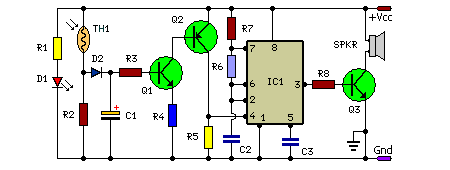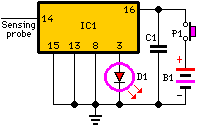
motion detector sensor circuit

This circuit is a motion detection sensor that utilizes a light source and a detector in the form of an infrared motion detector. The motion sensor employs an infrared LED and a phototransistor. The sensitivity of the sensor can be influenced by environmental factors such as wind, debris, or stray light. The schematic is divided into two parts: the transmitter and the receiver. The transmitter circuit is controlled by an NE555 timer configured as an astable multivibrator. An infrared LED is connected to the output of this schematic, generating a frequency of 5 kHz. In the receiver circuit, the infrared light emitted is captured by the phototransistor. Under normal conditions, when no motion is detected, the output of the LM1458 on pin 7 will be low (0 volts). When motion is detected, the output on pin 7 of the LM1458 IC will be high (5 volts). This output can be connected to a speaker, buzzer, or alarm. A PCB (printed circuit board) design for the motion detector sensor circuit is also included and available for download.
This motion detection sensor circuit is designed to detect movement by utilizing infrared technology. The transmitter section comprises an NE555 timer configured in astable mode, which generates a square wave signal at a frequency of 5 kHz. This signal drives an infrared LED that emits modulated infrared light. The modulation helps to distinguish the infrared signal from ambient light, enhancing the sensor's performance in various lighting conditions.
The receiver section consists of a phototransistor that is sensitive to the infrared light emitted by the transmitter. When the infrared light is interrupted by a moving object, the phototransistor's output changes state. In the absence of motion, the LM1458 operational amplifier maintains a low output on pin 7, indicating no detection. However, when motion is detected, the phototransistor allows current to flow, resulting in a high output (5 volts) from the LM1458.
This output can be utilized to trigger an alarm or alert system, such as a buzzer or speaker, providing an audible indication of motion detection. The circuit layout can be implemented on a printed circuit board (PCB), which simplifies construction and ensures reliable connections between components. The PCB design is available for download, allowing for easy replication of the motion detection sensor circuit. This design is suitable for various applications, including security systems, automated lighting, and occupancy detection.This circuit is a motion detection sensor, this circuit uses a light source and detector as a sensor infrared motion detector. Motion sensor using infrared LED and phototransistor. Because it uses light to the sensor sensitivity can be affected by environmental disturbances, such as wind, waste, or stray light.
In this schematic is divided into t wo schematic transmitter and receiver. Transmitter circuit is controlled by the NE555. NE555 astable multivibrator configuration installed. Infrared LED mounted on the output of a schematic and generate a frequency of 5 kHz. Here is a schematic drawing of motion detection sensor transmitter: At the receiver circuit of the LED infrared light captured by the phototransistor. At normal conditions ie when the sensor does not detect motion, LM1458 output on pin 7 will be value low (0 volts).
if the sensor detects movement, the LM1458 IC output on pin 7 will be value high (5 volts). IC LM1458 output can be connected with a speaker, buzzer or alarm. Here I also include a PCB (printed circuit board) of the motion detector sensor circuit and you can also download it. 🔗 External reference
This motion detection sensor circuit is designed to detect movement by utilizing infrared technology. The transmitter section comprises an NE555 timer configured in astable mode, which generates a square wave signal at a frequency of 5 kHz. This signal drives an infrared LED that emits modulated infrared light. The modulation helps to distinguish the infrared signal from ambient light, enhancing the sensor's performance in various lighting conditions.
The receiver section consists of a phototransistor that is sensitive to the infrared light emitted by the transmitter. When the infrared light is interrupted by a moving object, the phototransistor's output changes state. In the absence of motion, the LM1458 operational amplifier maintains a low output on pin 7, indicating no detection. However, when motion is detected, the phototransistor allows current to flow, resulting in a high output (5 volts) from the LM1458.
This output can be utilized to trigger an alarm or alert system, such as a buzzer or speaker, providing an audible indication of motion detection. The circuit layout can be implemented on a printed circuit board (PCB), which simplifies construction and ensures reliable connections between components. The PCB design is available for download, allowing for easy replication of the motion detection sensor circuit. This design is suitable for various applications, including security systems, automated lighting, and occupancy detection.This circuit is a motion detection sensor, this circuit uses a light source and detector as a sensor infrared motion detector. Motion sensor using infrared LED and phototransistor. Because it uses light to the sensor sensitivity can be affected by environmental disturbances, such as wind, waste, or stray light.
In this schematic is divided into t wo schematic transmitter and receiver. Transmitter circuit is controlled by the NE555. NE555 astable multivibrator configuration installed. Infrared LED mounted on the output of a schematic and generate a frequency of 5 kHz. Here is a schematic drawing of motion detection sensor transmitter: At the receiver circuit of the LED infrared light captured by the phototransistor. At normal conditions ie when the sensor does not detect motion, LM1458 output on pin 7 will be value low (0 volts).
if the sensor detects movement, the LM1458 IC output on pin 7 will be value high (5 volts). IC LM1458 output can be connected with a speaker, buzzer or alarm. Here I also include a PCB (printed circuit board) of the motion detector sensor circuit and you can also download it. 🔗 External reference





